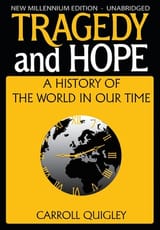“Tragedy and Hope: A History of the World in Our Time” by Carroll Quigley, published in 1966, is a comprehensive historical analysis spanning from the early 20th century to the mid-1960s, focusing on the development of Western civilization and global power structures. Quigley, a historian and professor at Georgetown University, aimed to provide an insider’s perspective on the forces shaping modern history, drawing on extensive research and access to elite networks.
The book argues that history is driven by the interplay of economic, political, and social forces, with a particular emphasis on the rise of financial power and its influence on governance. Quigley introduces the concept of a “network” of influential figures—bankers, politicians, and intellectuals—who worked to shape global events, notably through institutions like the Council on Foreign Relations and the Round Table groups. He suggests this network, while not a formal conspiracy, operated to maintain stability and promote Anglo-American dominance, especially after World War I and II.
